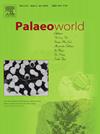Microclots in early Paleoproterozoic stromatolites from Dashiling Formation, Wutai, North China: Implications for microbial calcification and atmospheric CO2 levels during Great Oxidation Event
IF 1.7
3区 地球科学
Q2 PALEONTOLOGY
引用次数: 0
Abstract
The relationship between microbial calcification and atmospheric CO2 levels is a critical aspect of Earth’s biogeochemical evolution. This study presents the first detailed investigation of micro- and mesoscopic features of stromatolites from the 2.1 Ga Dashiling Formation of the Hutuo Group in Wutai area, North China, one of the best preserved microbialites during the Great Oxidation Event (GOE). The study identifies three types of microclots (microclots-1, -2 and -3) as key contributors to the formation of stromatolitic laminae in the Dashiling Formation. These microclots form layered, meshed, and dendritic microclotted laminae, characterized by alternation of light and dark laminae, with lighter laminae being sparsely distributed and darker laminae densely distributed. These alternations reflect the periodic growth and decay of microbial communities in response to dynamic environmental changes. The microclots and microclotted laminae in the Dashiling Formation exhibit evidence for microbial calcification, suggesting that atmospheric CO2 levels during the early Paleoproterozoic may have been lower than previously estimated. Previous studies have proposed that microbial calcification occurs extensively only when atmospheric CO2 declines to ∼10 times the present atmospheric level. The well-preserved microclots and calcified microbial structures in the Dashiling Formation suggest that atmospheric CO2 levels during the GOE may have approached or fallen below this threshold. While increased atmospheric O2 levels during the GOE may have influenced microbial calcification, our results indicate that declining CO2 levels played a more direct role in facilitating carbonate precipitation. These findings refine the understanding of the interplay between microbial activities, atmospheric CO2 decline, and carbonate saturation during the GOE, offering new insights into early Earth’s carbon cycle dynamics.
五台大岭组早古元古代叠层石中的微凝块:对大氧化事件时期微生物钙化和大气CO2水平的启示
微生物钙化与大气CO2水平的关系是地球生物地球化学演化的一个重要方面。本文首次详细研究了华北五台地区虎沱群2.1 Ga大岭组叠层石的微观和介观特征,该叠层石是大氧化事件(GOE)时期保存最完好的微生物岩之一。研究确定了3种类型的微凝块(微凝块-1、-2和-3)是大岭组叠层石纹层形成的关键因素。这些微凝块形成层状、网状和树突状的微凝层,具有明暗相间的特征,浅色层稀疏分布,深色层密集分布。这些变化反映了微生物群落对动态环境变化的周期性生长和衰减。大岭组的微凝块和微凝片层显示出微生物钙化的证据,表明早古元古代的大气CO2水平可能低于先前的估计。以前的研究已经提出,微生物钙化只有在大气CO2下降到目前大气水平的10倍时才会广泛发生。大岭组保存完好的微凝块和钙化的微生物结构表明,GOE时期的大气CO2水平可能已经接近或低于这一阈值。虽然GOE期间大气中O2水平的增加可能影响了微生物钙化,但我们的研究结果表明,CO2水平的下降在促进碳酸盐沉淀方面发挥了更直接的作用。这些发现完善了对GOE期间微生物活动、大气二氧化碳下降和碳酸盐饱和度之间相互作用的理解,为早期地球碳循环动力学提供了新的见解。
本文章由计算机程序翻译,如有差异,请以英文原文为准。
求助全文
约1分钟内获得全文
求助全文
来源期刊

Palaeoworld
PALEONTOLOGY-
CiteScore
4.00
自引率
5.90%
发文量
95
期刊介绍:
Palaeoworld is a peer-reviewed quarterly journal dedicated to the study of past life and its environment. We encourage submission of original manuscripts on all aspects of palaeontology and stratigraphy, comparisons of regional and global data in time and space, and results generated by interdisciplinary investigations in related fields. Some issues will be devoted entirely to a special theme whereas others will be composed of contributed articles. Palaeoworld is dedicated to serving a broad spectrum of geoscientists and palaeobiologists as well as serving as a resource for students in fields as diverse as palaeobiology, evolutionary biology, taxonomy and phylogeny, geobiology, historical geology, and palaeoenvironment.
Palaeoworld publishes original articles in the following areas:
•Phylogeny and taxonomic studies of all fossil groups
•Biostratigraphy, chemostratigraphy, chronostratigraphy
•Palaeoecology, palaeoenvironment and global changes throughout Earth history
•Tempo and mode of biological evolution
•Biological events in Earth history (e.g., extinctions, radiations)
•Ecosystem evolution
•Geobiology and molecular palaeobiology
•Palaeontological and stratigraphic methods
•Interdisciplinary studies focusing on fossils and strata
 求助内容:
求助内容: 应助结果提醒方式:
应助结果提醒方式:


